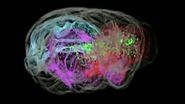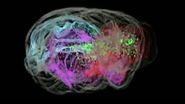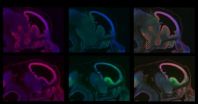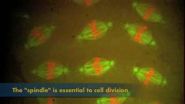(Press-News.org) VIDEO:
Scientists at the Salk Institute have uncovered details into a surprising -- and crucial -- link between brain development and BCRA1, a gene whose mutation is tied to breast and ovarian cancer.
Click here for more information.
LA JOLLA—Scientists at the Salk Institute have uncovered details into a surprising—and crucial—link between brain development and a gene whose mutation is tied to breast and ovarian cancer. Aside from better understanding neurological damage associated in a small percentage of people susceptible to breast cancers, the new work also helps to better understand the evolution of the brain.
The research, published this month in PNAS, shows that the gene known as BRCA1 has a significant role in creating healthy brains in mice and may provide a hint as to why some women genetically prone to breast cancer experience brain seizures.
"Previously, people associated mutations or deletions of BRCA1 with breast and ovarian cancer," says Inder Verma, a professor in Salk's Laboratory of Genetics and American Cancer Society Professor of Molecular Biology. "Our paper goes beyond this link to explain the protective mechanism of BRCA1 in the brain."
Through a three–lab collaboration at the Salk Institute, which began over a water cooler conversation between adjacent lab researchers 10 years ago, the work has culminated in dramatic findings. The team found that eliminating BRCA1 in neural stems cells had profound effects: large swaths of brain were simply missing; the cortex, which typically has six layers, only developed two very rudimentary layers; the cerebellum, which is normally made up of many folds and creases, was almost completely smooth; and the olfactory bulb, which processes odor information, was severely disorganized and poorly developed. Neurons were dying rapidly shortly after forming, while ones that did last were often defective. In mouse models, this resulted in interference in balance, motor skills, and other core functions.
How exactly was the absence of BRCA1 leading to such a neural catastrophe? In a previous paper, the team showed that without the protein coded by the BRCA1 gene, DNA is not packaged properly, becoming fragile and more likely to break during DNA replication. In this new paper, the researchers reveal more about that mechanism, showing that without the protective ability of BRCA1, breaks in the DNA strands go unfixed, prompting the molecule ATM kinase to activate a cellular "suicide" pathway involving a protein called p53. This pathway helps to halt the replication of damaged cells and is important in cancer research.
"BRCA1 acts by conferring stability to the DNA and preventing it from breaking," says Carlos G. Perez–Garcia, a Salk researcher in the Molecular Neurobiology Lab. "BRCA1 is important for all healthy cells."
When the researchers eliminated both BRCA1 and p53, they found the neurons grew at a normal rate, but still disorderly, with cells pointed in the wrong direction.
"In this scenario, we recover a lot of neurons but there's still a lot of abnormalities, such as cells that are sideways and pointed the wrong direction," says Gerald Pao, who, along with Quan Zhu and Perez–Garcia, is a primary contributor to the paper and Salk researcher.
This observation led the team to propose that BRCA1 has an additional role in assisting neurons in orienting: the gene acts on the centromere of DNA—essentially an anchor for the chromosome arms essential in cell replication—to tell the new cell in which direction to grow, providing guidance in developing the brain's organized layers.
"It is remarkable that BRCA1 has such a significant effect on the brain, especially size. This work leads us to a better understanding of how to protect neurons," says Verma, who is also the Irwin and Joan Jacobs Chair in Exemplary Life Science. Because BRCA1 seems to regulate the centromere, studying the gene will help scientists to understand how mammalian brains have evolved over time.
"Now we have an explanation for why some patients with breast cancer also experienced brain seizures," adds Pao. This knowledge could potentially help identify breast cancer–susceptible patients predisposed to seizures and provide appropriate treatments.
INFORMATION:
This work was a collaboration among researchers in the labs of Inder Verma, Dennis O'Leary, holder of the Institute's Vincent J. Coates Chair in Molecular Neurobiology Fred Gage, holder of Salk's Vi and John Adler Chair for Research on Age–Related Neurodegenerative Disease.
About the Salk Institute for Biological Studies:
The Salk Institute for Biological Studies is one of the world's preeminent basic research institutions, where internationally renowned faculty probe fundamental life science questions in a unique, collaborative, and creative environment. Focused both on discovery and on mentoring future generations of researchers, Salk scientists make groundbreaking contributions to our understanding of cancer, aging, Alzheimer's, diabetes and infectious diseases by studying neuroscience, genetics, cell and plant biology, and related disciplines.
Faculty achievements have been recognized with numerous honors, including Nobel Prizes and memberships in the National Academy of Sciences. Founded in 1960 by polio vaccine pioneer Jonas Salk, M.D., the Institute is an independent nonprofit organization and architectural landmark.
Scientists reveal potential link between brain development and breast cancer gene
2014-04-08
ELSE PRESS RELEASES FROM THIS DATE:
Why binge drinkers are slower to heal from their wounds
2014-04-08
MAYWOOD, Ill. – People who are injured while binge drinking are much slower to heal from wounds suffered in car accidents, shootings, fires, etc.
Now a new study is providing insights into why alcohol has such a negative effect on wound healing. Loyola University Chicago Stritch School of Medicine researchers report that binge alcohol exposure significantly reduced levels of key components of the immune system involved in healing.
The study by senior author Katherine A. Radek, PhD, and colleagues from Loyola's Alcohol Research Program and the Infectious Disease and ...
Global health funding reaches new high as funding priorities shift
2014-04-08
Washington, D.C.—Global health funding hit an all-time high of $31.3 billion in 2013, five times greater than in 1990. Yet with 3.9% growth from 2012 to 2013, the year-over-year increase falls short of the rapid rates seen over the previous decade, according to new research by the Institute for Health Metrics and Evaluation (IHME) at the University of Washington being published online in a web first edition on April 8 by Health Affairs.
As funding from many bilateral donors and development banks has declined, growth in funding from the GAVI Alliance, the Global Fund ...
UNC researchers find genetic trigger for RSV-induced infant hospitalizations
2014-04-08
April 8, 2014 CHAPEL HILL, N.C. – Researchers at UNC School of Medicine have pinpointed a viral protein that plays a major role in making respiratory syncytial virus (RSV) the most common cause of hospitalization in children under one year of age.
The discovery, published April 8 in the Journal of Clinical Investigation, is the first step toward identifying better diagnostics and potential treatments for an infection that strikes nearly all children before they reach the age of three and causing severe disease in 3 percent of infected children. RSV infection leads to ...
The double whammy of multiple sex partners and drinking in HIV/STI prevention
2014-04-08
PHILADELPHIA (April 8, 2014) – The cartoon character Homer J. Simpson once said "Alcohol: The source of, and solution to, all of life's problems."
The sage of the ubiquitous and fictional town of Springfield may have hit the nail on the head when it comes to human immunodeficiency virus (HIV) and sexually transmitted infections (STIs) counseling and prevention. The more you drink and/or the more sex partners you have, the less likely you are to engage in HIV-prevention programs.
This rather grim assessment came about from the study, "Barriers to accessing HIV-prevention ...
Language structure… you're born with it
2014-04-08
Humans are unique in their ability to acquire language. But how? A new study published in the Proceeding of the National Academy of Sciences shows that we are in fact born with the basic fundamental knowledge of language, thus shedding light on the age-old linguistic "nature vs. nurture" debate.
THE STUDY
While languages differ from each other in many ways, certain aspects appear to be shared across languages. These aspects might stem from linguistic principles that are active in all human brains. A natural question then arises: are infants born with knowledge of how ...
Advanced warning systems increase safety at intersections, study shows
2014-04-08
Most drivers have experienced a traffic signal that turns yellow just as they approach an intersection, which makes it difficult for them to decide whether to stop or proceed through it. The wrong choice in this situation, known as the "dilemma zone," may lead to crashes, especially at high-speed intersections.
A major factor making driving difficult is hazards that are sudden and hard to predict. Roadside and in-vehicle display warning systems may help drivers handle these hazards by predicting their occurrence and providing advanced warning to the driver, according ...
Lipid levels during prenatal brain development impact autism: York U study
2014-04-08
In a groundbreaking York University study, researchers have found that abnormal levels of lipid molecules in the brain can affect the interaction between two key neural pathways in early prenatal brain development, which can trigger autism. And, environmental causes such as exposure to chemicals in some cosmetics and common over-the-counter medication can affect the levels of these lipids, according to the researchers.
"We have found that the abnormal level of a lipid molecule called Prostaglandin E2 in the brain can affect the function of Wnt proteins. It is important ...
Kinesin-5 structure opens cancer drug targets
2014-04-08
VIDEO:
Kinesin-5 plays a crucial role in cell division by allow microfilaments to slide past each other. The kinesin-5 structure shows a central rod connecting two motor units that walk along...
Click here for more information.
The structure of a key part of the machinery that allows cells to divide has been identified by researchers at the University of California, Davis -- opening new possibilities for throwing a wrench in the machine and blocking runaway cell division in cancer.
"The ...
Phase II trial of efatutazone shows challenge of matching treatment to population
2014-04-08
Work at the University of Colorado Cancer Center led to phase II trial of efatutazone with erlotinib in patients with refractory non-small cell lung cancer. Results are reported today at the American Association for Cancer Research (AACR) Annual Meeting 2014. While efatutazone did not improve the efficacy of erlotinib in this trial, researchers hope lessons from the trial will allow them to make better future use of the drug or other drugs in its class.
"In oncology and especially in lung cancer, everything is personalized. We're exploring different molecular markers ...
Glucosamine promotes longevity by mimicking a low-carb diet
2014-04-08
Glucosamine has been freely available in drugstores for many decades. It is widely used to treat arthritis and to prevent joint degeneration. Moreover, glucosamine is known to delay cancer growth. In addition, glucosamine reduces metabolism of nutritive sugars, as was already shown some 50 years ago.
In 2007, Michael Ristow showed that too much nutritive sugar shortens the lifespan of roundworms, a widely studied model organism in ageing research. Conversely, impairing carbohydrate metabolism in these worms was capable of extending lifespan [reference 1]. Unfortunately, ...





